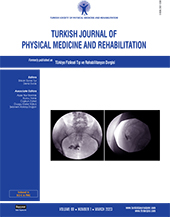High-frequency whole-body vibration activates tonic vibration reflex
2 Department of Physical Medicine and Rehabilitation, Istanbul Physical Therapy Rehabilitation Training and Research Hospital, Istanbul, Türkiye
3 Department of Physical Medicine and Rehabilitation, Gaziosmanpaşa Training and Research Hospital, Istanbul, Türkiye DOI : 10.5606/tftrd.2023.10854 Objectives: The aim of this research was to examine whether high-frequency whole-body vibration activates the tonic vibration reflex (TVR).
Patients and methods: The experimental study was conducted with seven volunteers (mean age: 30.8±3.3 years; range, 26 to 35 years) between December 2021 and January 2022. To elicit soleus TVR, high-frequency (100-150 Hz) vibration was applied to the Achilles tendon. High-frequency (100-150 Hz) whole-body vibration and low-frequency (30-40 Hz) whole-body vibration were applied in quiet standing. Whole-body vibration-induced reflexes were recorded from the soleus muscle using surface electromyography. The cumulative average method was used to determine the reflex latencies.
Results: Soleus TVR latency was 35.6±5.9 msec, the latency of the reflex activated by high-frequency whole-body vibration was 34.8±6.2 msec, and the latency of the reflex activated by low-frequency whole-body vibration was 42.8±3.4 msec (F(2, 12)=40.07, p=0.0001 , h2=0.87). The low-frequency whole-body vibration-induced reflex latency was significantly longer than high-frequency whole-body vibrationinduced reflex latency and TVR latency (p=0.002 and p=0.001, respectively). High-frequency whole-body vibration-induced reflex latency and TVR latency were found to be similar (p=0.526).
Conclusion: This study showed that high-frequency whole-body vibration activates TVR.
Keywords : Latency, muscle spindle, muscle strength, vibration

















